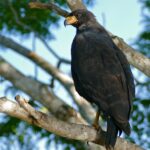There is only one type of great black hawk (Buteogallus urubitinga), a tropical bird of prey found in the southern tip of Mexico and southward through the northern half of South America. This species is not to be confused with other similar hawks such as the common black hawk, Cuban black hawk, Harris’s hawk, zone-tailed hawk, or black solitary eagle.
The Great Black Hawk
The great black hawk is a large raptor with mainly black or dark grey plumage, a short black tail with a white base and black and white terminal edge, a black tipped bill, and yellow legs and cere. It weighs around 1100 grams and prefers to be near water in fields and forests. Its diet mainly consists of mammals, birds, fish, crabs, and reptiles.
Physical Characteristics
- Plumage: Mainly black or dark grey
- Tail: Short, black with white base and black and white terminal edge
- Bill: Black tipped
- Legs and Cere: Yellow
- Weight: Around 1100 grams
Habitat and Diet
- Habitat: Near water in fields and forests
- Diet: Mammals, birds, fish, crabs, reptiles
Conservation Status
The conservation status of the great black hawk is least concern.
Comparison with Similar Hawk Species
 Image source: Great Black Hawk by Bernard DUPONT
Image source: Great Black Hawk by Bernard DUPONT
While the great black hawk is the only species in its genus, there are several other similar-looking hawk species that are important to distinguish:
Common Black Hawk (Buteogallus anthracinus)
- Smaller in size than the great black hawk
- Usually has no white showing on the upper-tail while perched
- Range includes North America
- Prefers groves or open forests with streams close by
- Diet includes crustaceans, insects, reptiles, mammals, and carrion
- Conservation status: Least concern
Cuban Black Hawk (Buteogallus gundlachii)
- Found in Cuba, mainly in coastal and mangrove regions, and wooded areas
- Has distinct white panels near the end of its under-wings
- Diet includes crabs, fish, rodents, lizards, and carrion
- Conservation status: Near threatened due to habitat degradation
Harris’s Hawk (Parabuteo unicinctus)
- Larger than the great black hawk
- Has reddish-brown plumage with white patches on the wings and tail
- Found in the southwestern United States and Mexico
- Hunts cooperatively in groups
- Diet includes small mammals, birds, reptiles, and insects
- Conservation status: Least concern
Zone-tailed Hawk (Buteo albonotatus)
- Smaller than the great black hawk
- Has a distinctive black and white banded tail pattern
- Found in the southwestern United States and Mexico
- Prefers open woodlands, savannas, and canyons
- Diet includes small mammals, birds, reptiles, and amphibians
- Conservation status: Least concern
Black Solitary Eagle (Buteogallus solitarius)
- Larger than the great black hawk
- Has a distinctive white patch on the underwing
- Found in Central and South America
- Prefers forested and mountainous areas
- Diet includes small mammals, birds, reptiles, and amphibians
- Conservation status: Near threatened
In conclusion, the great black hawk is the only species in its genus and is found in the southern tip of Mexico and throughout the northern half of South America. It is important to distinguish it from other similar-looking hawk species based on its physical characteristics, habitat, and diet.
References:
- Hawk | Types, Diet, & Facts | Britannica. Available at: https://www.britannica.com/animal/hawk-bird
- 124 Types of Hawks – Avibirds.com. Available at: https://avibirds.com/types-of-hawks/
- Great Black Hawk – North American Hawks – Birds of North America. Available at: https://www.birds-of-north-america.net/Great_Black_Hawk.html


